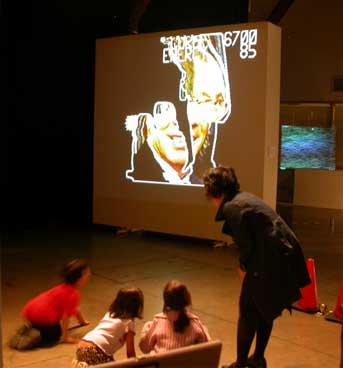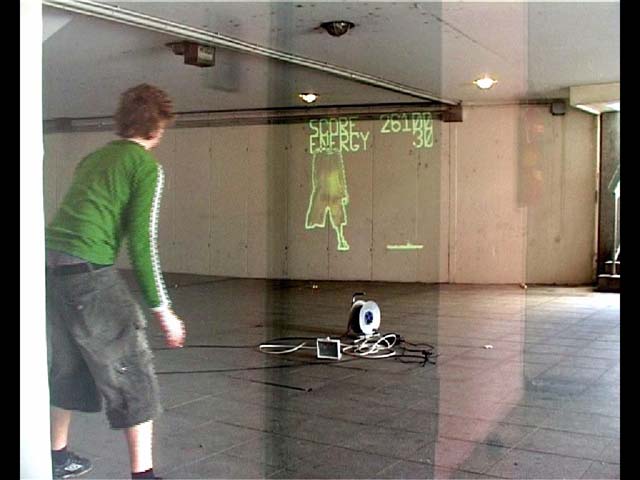(t)Error - The trademark of Error
Critic from media - artist, activists, theorists
Look at this to see how this game works in public space
Download Setup Instructions (english)
Game and Reality
(t)Error - what a funny game
Whom would you like to play to get the world back into right shape? George
W. Bush, Osama Bin Laden, or rather Tony Blair? Starting the computer
game (T)ERROR, the player is spoilt for choice. A camera tracks the player’s
movements and a projector throws the players outlines in original size
on a white wall in front of him, all in realtime.
When the player kicks, his shadow will kick. When the player ducks or
jumps to avoid bumping into an enemy jet, his shadowy avatar will do exactly
the same in real time.
The empty silhouette of the player gets filled out - and this is the players
choice – with the face of George W. Bush, the flag of a state which
supported the Iraq war, or the body of Osama Bin Laden.
For gaining a good game score, you will have to fight evilly.
Being slipped into this stereotype role, you have to avoid tanks, submarines
and fighter planes, you have to collect oil pumps and dollar notes, and
you have to kick civilians begging for help. If you succeed in all these
matters, you are the lucky winner and rise to the next game level.
1. (T)ERROR criticizes the Iraq war
„Art is the cry of distress uttered by those who experience at first
hand the fate of mankind.“ (Holtzman/Schönberg, 1994)
This interactive video installation is my reaction on the Afghanistan
campaign and the following Iraq war. It is a political persiflage on world
politics, a mixed-reality game, which playfully tempts - through the whole
body interaction - to participate, but at the same time the not very playful
content of (T)ERROR wants to provoke reflection and self-reflection.
This play with the aspects of fun and seriousness or game and reality
forms the basis of my work and media analysis.
Laughter lures the visitors, and not only an elitist gallery audience,
but also the people from the street, who do not know too much about contemporary
art. Fun, games and interaction cause motion, it is then much easier to
get involved in the game, and so the change from laughter to sadness is
more powerful and obvious.
2. (T)ERROR criticizes the young “gaming culture”
To transform this combination of laughing and crying into the world of
computer games, and so into the world of our children, was my main aim.
“Fifty percent of all Americans age six and older play computer
and video games.” (http://www.theesa.com/pressroom.html, 20.4.04)
„In 1998, over one in four American youngsters reported playing
games between seven and 30 hours a week. More than one in four homes has
a game console.” (Nideffer, Robert F., Shift-ctrl)
This is one of the reasons why I like to show my installation at parties
and clubs.
This year at the beginning of april, for example, (T)ERROR was exhibited
in Berlin, in the “Club zur Möbelfabrik”. The young audience
of this venue participated with enthusiasm. The reflection hit them a
couple of minutes later, when the youngsters squatted down besides the
installation, tired after the exhausting movements.
“I just played Osama Bin Laden in the game. I was killing people.
Was that fun?”
And this is what makes the artistic examination of computer games so precious
and powerful:
The sudden liberation, which is triggered by the dramaturgy of computer
games, the role games par excellence. Nowhere else it is as simple and
as easy to slip into the role of authorities, to play with the overthrow
of established social systems and experience the dynamism of action and
reaction without any danger.
At the same time, (T)ERROR provides its players with a strange closeness
and directness:
It’s not a joystick that helps our avatars to jump hundred metres
high, but everyone is actively playing him/herself.
(T)ERROR is an attempt to dismantle the gaming industry and the stereotype
roles and behaviour patterns taught by it. All these are the semiotics
our children are confronted with since birth. We need to analyze them
to get to know our children’s world.
The simple, pixel graphics of my game was developed following early, famous
computer games like for example Space Invaders or Defender.
(T)ERROR creates a managable (art) space, a system of signs and symbols,
which are well known by the followers of computer games, who always associate
these sign systems with fun and leisure time.
Society codes and conventions which everyone takes for granted, can now
be seen from a different perspective and open up new possibilities for
dialogue and debate.
3. (T)ERROR criticizes the media society
Our contemporary life and society consist out of brainwashing media flashes,
consumption and pseudo-happiness paired with a upcoming depression. My
work uses the same media and the same mechanisms the goal is the deconstruction
of this failed system and a reflection of this media junked fake.
Just the unbroken popularity and fascination of computer games speaks
for an artistic analysis. There is a whole “culture of external
activities that has developed around these games – from trading
of customized game patches to demands that the manufacturer provide more
levels, to whole web sites devoted to one’s avatars (Gemstone’s
home page lists close to 200 such player-run sites)” (La Farge 2000,
p10)
In consequence of her examination, Antoinette La Farge stresses that in
the near future, computer games will be as important in the modern cultural
landscape as art, music or film.
4. (T)ERROR criticizes the abuse of computer games through military and
economy
Another important point of criticism shown in (T)ERROR lies in the close
connection of computer games with military and economy.
„It’s now fairly common knowledge that Operation Desert Storm
was prepped for by doing simulation strategy exercises down in Florida,
and that the US military is currently pumping large amounts of capital
into figuring out how to appropriate gaming principles for battle training
in massively mulituser SimNet environments.” (Nideffer, Robert F.,
Shift-ctrl)
This list of strange simultaneities and surprising cooperations could
go on and on and on.
“According to the Interactive Digital Software Association’s
1999 sales information, over 6.1 billion dollars in U.S. entertainment
software sales in 1999 went to games.” (Nideffer, Robert F., Shift-ctrl)
In a time where professional computer games have more production budgets
as Hollywood films, you must question this media, analyse it artistically
and bring it up in a topic. A whole generation grows up with games, mostly
just having one goal: “You achieve your aims with violence.”
Artists and creative must click in at this point, dismantle these games,
rearrange them with new ideas and reflect the media itsself. The transformation
and modification of games are also interesting in the historical context,
if you consider that military institutions have taken a great part in
the development of this gaming technology.
With the second version of a modified 3D Shooter the American Army is
at the present time hunting for new recruits; let’s hope that this
shot was off target.

error.jpg)
error3.jpg)


error2.jpg)
(t)error was selected as upcoming artistic work and honoured with a grant by MAD 03 Madrid Spain
(t)error featured in Violence Online Festival Version 9.0 click enter and my work can be found in the violence magazine
(t)error was exhibited in Berlin at Club der polnischen Versager und Galerie "Zur Möbelfabrik" at the rebelArt Festival check the pics here
(t)error was voted under the 30 best works of Machinista 2004
Additional Credits:
Soundtrack by:
Jennifer Carlile(USA) www.atonaltrek.com
More about
For me it was important
to make this piece, because I see so many media art works which are just
a technical try or a demonstration for a certain technique or visual amusement.
There’s seldom a message transported with the media, no one plays
with the media or uses it in a kicking for me appropriate way.
Media art should give the recipients an experience and a feeling, it should
tell them something. That’s what I tried with (t)error, I used my
skills as a programmer and an artist to realise my critics on world politics
and warfare. For me it’s important to rise my voice, and my media
is the computer so I express my feelings in the appropriate way, with
this installation.
The concept of the game is quite simple, the player first can choose his
axe of evil, that means who he wants to be, like the countries contributed
in the war, George Bush, Tony Blair, Bin Laden, etc., then the game starts
and you have to grab for dollar signs and oil pumps, kill civilians and
destroy their houses, which gets you score, on the other hand you have
to avoid fighter planes, tanks and submarines.
For me it was a counterpoint to use a game as a platform for my work,
because all the war, all the world politics is like a game as well. On
the other hand console kiddies are playing “First Person Shooters”
and aren’t interested in politics at all, so maybe I am able to
reach them with my installation. Where they can play around and maybe
get the point I am trying to state.
Technical description
With the help of a video camera, in front of the projection plane, I am detecting the silhouettes of the player. The player stands in front of a monotone coloured wall, the color is not of relevance. A projector displays the content from the back or from the front to the projection plane. When using front projection, the camera is adjusted underneath the projection plane so it’s not disturbed by the lights of the projector, infrared can be used as well, which makes the shape recognition superb perfect. The piece can be shown on a plasma display as well. For the sound track and the sound effects two speakers and a computer with a soundcard are needed.
Analysed frame of camera
Minimum Hardware
Requirements
1 x computer: Intel Pentium IV 2,0 GHz equipped with standard graphic
card
1x Soundcard
1 x cheap webcam or framegrabber and a pal cam
1 x video projectors or plasma as display medium or amonitor (Resolution
320x240)
Software
OpenCV (Open Source Computer vision library)
IPP (Intel High Performance Computer Vision Library)
Customised algorithms
Microsoft DirectShow